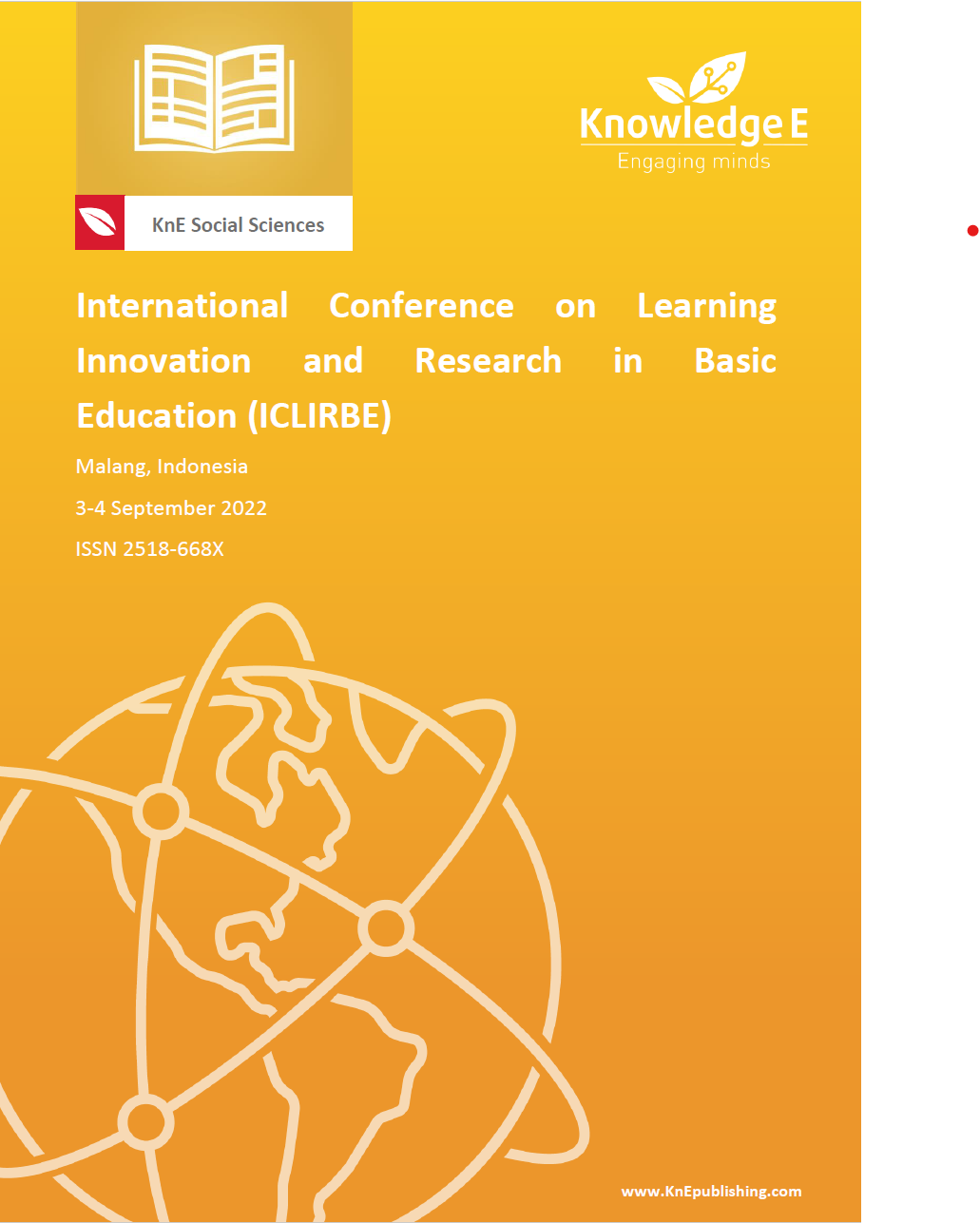Innovation of Mathematics Learning Models and Media in Elementary Schools in Kurikulum Merdeka Belajar
DOI:
https://doi.org/10.18502/kss.v8i8.13302Abstract
Mathematics learning aims to build students’ intellectual, creative, and logical mindsets. This goal can be achieved if learning can be carried out optimally. With technological advances in the independent learning curriculum, there needs to be innovations in the implementation of Mathematics learning in elementary schools. This study aims to examine the innovation of mathematics learning models and media in elementary schools in the independent learning curriculum. The method used in this research is a qualitative method of literature study, by reviewing articles of national and international repute. The results of this study indicate that there are several innovations in the mathematics learning model including the realistic mathematical education (RME) model, open minded problem-based learning, STEAM, blended learning, auditory intellectually repetition (AIR), and computational thinking (CT). While innovations in mathematics learning media include environment-based videos, Tinkercad, Arduino, and Chibitronics.
Keywords: Mathematics learning innovation, model, media, elementary school
References
[2] A. Bicer, A. Bicer, C. Perihan, and Y. Lee, “Pre?service teachers’ preparations for designing and implementing creativity?directed mathematical tasks and instructional practices,” Mat, vol. 1, 2022, [Online]. Available: https://doi.org/10.1007/s13394-022- 00409-x.
[3] M. P. Rezky, J. Sutarto, T. Prihatin, A. Yulianto, I. Haidar, and A. Surel, “Seminar Nasional Pascasarjana 2019.,” Gener. Milen. yang Siap Menghadapi Era Revolusi Digit. (Society 5.0 dan Revolusi Ind. 4.0) di Bid. Pendidik. Melalui Pengemb. Sumber Daya Mns., no. Universitas Negeri Semarang, pp. 1118–1125, 2019.
[4] M. Thohir, “From disruption to mobilization: Ire teachers’ perspectives on independent learning policy,” Cakrawala Pendidik., vol. 40, no. 2, pp. 359–373, 2021, doi: 10.21831/cp.v40i2.39540.
[5] A. Mudhofi, “No FILSAFAT SEBAGAI WAHANA PENDIDIKAN MENUJU KEMANDIRIAN BANGSATitle,” Cakrawala Pendidik., vol. XXXII, 2013.
[6] M. A. Nuryatno, “Critical Remarks on Educational Philosophy of Paulo Freire,” J. Cakrawala Pendidik., vol. 1, no. 1, pp. 1–16, 2015, doi: 10.21831/cp.v1i1.1542.
[7] E. Istikhoirini, “Studi Literatur : Edmodo sebagai Media Pembelajaran Matematika Daring dalam Era Merdeka Belajar di Masa Pandemi,” ProSANDIKA UNIKAL (Prosiding Semin. Nas. Pendidik. Mat. Univ. Pekalongan), vol. 2, no. 1, pp. 11–18, 2021, [Online]. Available: https://proceeding.unikal.ac.id/index.php/sandika/article/view/500.
[8] J. Hughes, G. Gadanidis, and C. Yiu, “Digital Making in Elementary Mathematics Education,” Digit. Exp. Math. Educ., vol. 3, no. 2, pp. 139–153, 2017, doi: 10.1007/s40751-016-0020-x.
[9] S. Llinares, “Instructional quality of mathematics teaching and mathematics teacher education,” J. Math. Teach. Educ., vol. 24, no. 1, pp. 1–3, 2021, doi: 10.1007/s10857- 021-09488-2.
[10] G. M. Lloyd, C. L. Rice, and A. V. McCloskey, “Opportunities for professional learning about mathematics instruction: the role of joint work in student-teaching triads,” J. Math. Teach. Educ., vol. 23, no. 5, pp. 499–525, 2020, doi: 10.1007/s10857-019- 09439-y.
[11] S. Revina and F. K. S. Leung, “Educational Borrowing and Mathematics Curriculum: Realistic Mathematics Education in the Dutch and Indonesian Primary Curriculum,” Int. J. Emerg. Math. Educ., vol. 2, no. 1, p. 1, 2018, doi: 10.12928/ijeme.v2i1.8025.
[12] S. Fowler, C. Cutting, S. H.D.Fiedler, and S. N. Leonard, “Design?based research in mathematics education: trends, challenges and potential,” Math. Educ. Res. J., 2021, [Online]. Available: https://doi.org/10.1007/s13394-021-00407-5%0A.
[13] I. L. Purnama and E. Aldila, “Kemampuan Komunikasi Matematis Siswa Ditinjau Melalui Model Pembelajaran Kooperatif Tipe Complete Sentence Dan Team Quiz,” J. Pendidik. Mat., vol. 10, no. 1, pp. 27–43, 2016, doi: 10.22342/jpm.10.1.3267.26-41.
[14] J. Skott, “Understanding mathematics teaching and learning ‘in their full complexity,”’ J. Math. Teach. Educ., vol. 22, no. 5, pp. 427–431, 2019, doi: 10.1007/s10857-019- 09446-z.
[15] S. H. Noer, “Mengembangkan Keterampilan Berpikir Kreatif Matematis dan Pembelajaran Matematika Berbasis Masalah Open-Ended,” J. Pendidik. Mat., vol. 5, no. 1, p. 100, 2011.
[16] K. Quane, M. Chinnappan, and S. Trenholm, “Draw yourself doing mathematics: developing an analytical tool to investigate the nature of young children’s attitudes towards mathematics,” Math. Educ. Res. J., no. 0123456789, 2021, doi: 10.1007/s13394-021-00399-2.
[17] V. Caggiano, “Towards identifying the soft skills needed in curricula: Finnish and italian students’ self-evaluations indicate differences between groups,” Sustain., vol. 12, no. 10, 2020, doi: 10.3390/SU12104031.
[18] S. Psycharis, “Steam in Education: a Literature Review on the Role of Computational Thinking, Engineering Epistemology and Computational Science. Computational Steam Pedagogy (Csp),” S. Psycharis Sci. Cult., vol. 4, no. 2, pp. 51–72, 2018, doi: 10.5281/zenodo.1214565.
[19] E. Marlina, “Pengembangan Model Pembelajaran Blended Learning Berbantuan Aplikasi Sevima Edlink,” J. Padegogik, vol. 3, no. 2, pp. 104–110, 2020.
[20] S. Krogh, N. Annette, H. Bjerke, and L. Mifsud, “Computational Thinking in the Primary Mathematics Classroom : a Systematic Review,” Digit. Exp. Math. Educ., no. 1, 2022, doi: 10.1007/s40751-022-00102-5.
[21] M. M. Alqahtani, J. A. Hall, M. Leventhal, and A. N. Argila, “Programming in Mathematics Classrooms: Changes in Pre-service Teachers’ Intentions to Integrate Robots in Teaching,” Digit. Exp. Math. Educ., no. 0123456789, 2021, doi: 10.1007/s40751-021-00096-6.
[22] N. Calder, “Using Scratch to Facilitate Mathematical Thinking,” Waikato J. Educ., vol. 2, pp. 43–58, 2019.
[23] D. G. Yildiz, A. Osmanoglu, and F. G. Alayli, “Providing a video?case?based professional development environment for prospective mathematics teachers to notice students’ misconceptions in measurement,” J. Math. Teach. Educ., vol. 1, 2021, [Online]. Available: https://doi.org/10.1007/s10857-021-09525-0.
[24] B. D. Kane and E. S. Saclarides, “Doing the math together: coaches’ professional learning through engagement in mathematics,” J. Math. Teach. Educ., no. 0123456789, 2022, doi: 10.1007/s10857-021-09527-y.
[25] W. R. Widjayanti, T. Masfingatin, and R. K. Setyansah, “Media Pembelajaran Interaktif Berbasis Animasi Pada Materi Statistika Untuk Siswa Kelas 7 Smp,” J. Pendidik. Mat., vol. 13, no. 1, pp. 101–112, 2018, doi: 10.22342/jpm.13.1.6294.101-112.
[26] F. DIlling and A. Vogler, “Fostering spatial ability through computer-aided design: A case study,” Digit. Exp. Math. Educ., vol. 2, no. 7, pp. 323–336, 2021.
[27] F. Pielsticker, I. Witzke, and A. Vogler, “Edge Models with the CAD Software: Creating a New Context for Mathematics in Elementary School,” Digit. Exp. Math. Educ., vol. 7, no. 3, pp. 339–360, 2021, doi: 10.1007/s40751-021-00092-w.

